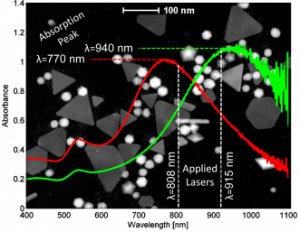
Working with gold nanoplates from our collaborators in the O’Toole group, we are looking at thermal expansion in thin films as a way to bend microscale beams. These nanoparticles can be highly wavelength selective. We found that we could achieve selective heating of surfaces coated with two different nanoparticle “species” using two different wavelengths. Meaning, one day you might be able to make your nanodevice do a complex dance by flashing two or more different lasers at it. No wires needed! Both wavelengths we used are in the biological “water window” of near-infrared that can go through tissue.
Nanoparticles such as these also have applications in strain sensing–potentially very useful for our shape-detection work– and in locally increasing the etch rate through materials. They were originally studied for their fascinating photonic properties, and a major motivation for their development is photothermal cancer therapy.
Both our IR sources came from Dragon Lasers (and safety glasses from noIR)